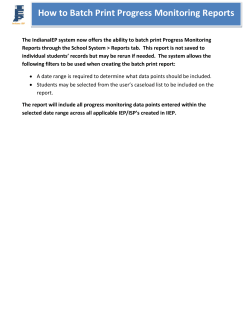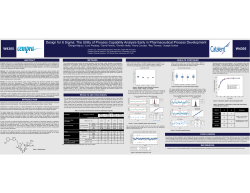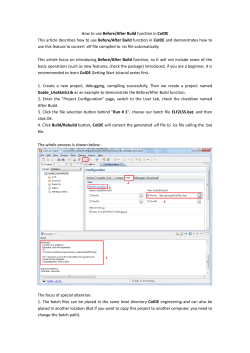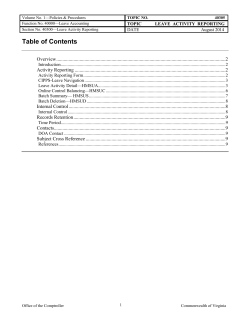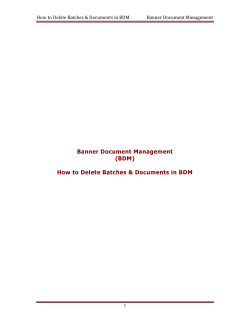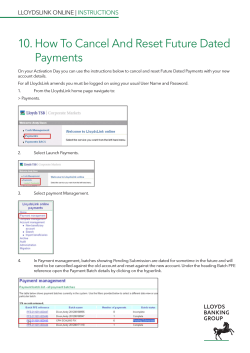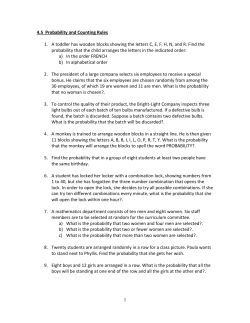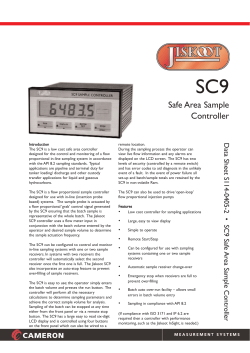
Document 427504
Design of Experiments: Critical Process Parameters Confirmation for the Scale-up Manufacturing of Solithromycin 200 mg Capsules Lovy Pradeep1, Christin Hollis2, Shingai Majuru1, Harry Cocolas2, David Pereira1 W4344 1 Cempra Pharmaceuticals, Inc., 6320 Quadrangle Drive, Suite 360, Chapel Hill, NC 27517 Pharma Solutions, 1100 Enterprise Dr., Winchester, KY 40391 2 Catalent MATERIALS AND METHODS The manufacturing process and the process equipment used is shown in Figure 2. Solithromycin (Figure 1) is a fourth generation macrolide, the first fluoroketolide, which is in Phase 3 clinical trials for Community Acquired Bacterial Pneumonia (CABP). One of the dosage forms under development is an immediate release 200 mg hard gelatin capsule for oral administration. The formulation contains 200 mg solithromycin per capsule with the excipients Microcrystalline Cellulose, Croscarmellose Sodium, Sodium Lauryl Sulfate, Povidone, and Magnesium Stearate. As part of the capsule development work, the process for manufacturing solithromycin capsules 200 mg was optimized, and the operating ranges for the critical process parameters identified at the 5-kg scale, using a Design of Experiments (DOE) approach, consistent with Quality by Design (QbD) principles. In preparation for registration batches manufacture, it was essential to demonstrate that the process optimized at the 5-kg scale was scalable to the 52-kg scale. The purpose of these studies was to demonstrate that when scaled to the registration batch size of 52 kg, the manufacturing process produced drug product that met the pre-determined drug product specifications. Molecular Formula: C43H65FN6O10 Molecular weight: 845.02 FIGURE 1. MOLECULAR STRUCTURE OF SOLITHROMYCIN Blending (5 ft3 V-blender; 70 kg capacity Magnesium Stearate FIGURE 2. MANUFACTURING PROCESS FLOW CHART AND EQUIPMENT USED The parameters used for the manufacture of the scale-up batch were obtained through a DOE study. For the scale-up and ensuing registration batches, the amount of water used for granulation was approximately 99.4% w/w relative to the dry weight of the batch and the total kneading time was NMT 10 minutes. The process parameters for wet granulation are listed in Table 1. For the registration batches, however, all the water for a given batch was added at one time instead of two separate additions. Milling (Comil) Range Actual Readings 20-mesh screen NA Materials passed through 30 - 70 RPM NA 100 - 160 RPM 2000 - 3000 RPM 100 - 160 RPM Cross Screw = 2500 RPM 2000 - 3000 RPM Impeller = 125 RPM Cross Screw = 2500 RPM Impeller = 125 RPM Cross Screw = 2500 RPM 65 oC 600 – 900 cfm NMT 12 oC 48 oC 100 - 160 RPM 2000 - 3000 RPM 100 - 160 RPM 2000 - 3000 RPM 60 - 70 oC 600 - 900 cfm NMT 12 oC NLT 48 oC Empty Capsule shells 0.5 mm screen, 1500 RPM 40-mesh screen 25 rpm Size 0 hard gelatin capsules Encapsulation Average capsule shell weight Target Gross Filled Capsule Weight (Capsule filler, Weight (GFW) checker, Metal detector) Filled capsule weight control Weighting sorting Average of 10 capsules 325 mg + empty capsule shell UCL = GFW x 1.05 LCL = GFW x 0.95 Test 2 minutes Blend (Pooled dry milled granulation) ~1.3 minutes NA 418 mg LCL - UCL 397-439 mg Cumulative Particle Size Distribution (PSD) (See Figure 3) Blend Uniformity by HPLC (See Figure 4) Optical Rotation Uniformity of Dosage Units (n=30) (See Figure 5) Dissolution Profiles at Begin (B), Mid (M), and End (E) intervals (See Figure 6) Encapsulation (Stratified) Assay by HPLC XRPD Encapsulation (Bulk) (Release Testing) Optical Rotation Dissolution Profiles (See Figure 7) Moisture (LOD) Uniformity of Dosage Units 640 635 630 Batch 1402287 60 Batch 1402288 Batch 1402289 40 620 1.64 - 2.32% 1.48 – 1.96% 1.60 – 1.76% For Information Only (FIO) FIO >0.58 g/mL 2.70% 0.50 g/mL 0.61 g/mL 40-mesh: 22.5% 80-mesh: 51.3% 100-mesh: 59.5% 140-mesh: 71.0% 200-mesh: 91.5% 270-mesh: 95.5% Pan: 99.7% 2.72% 0.50 g/mL 0.63 g/mL 40-mesh: 26.2% 80-mesh: 59.0% 100-mesh: 64.4% 140-mesh: 73.6% 200-mesh: 89.1% 270-mesh: 93.3% Pan: 100.0% 2.99% 0.52 g/mL 0.63 g/mL 40-mesh: 30.2% 80-mesh: 59.4% 100-mesh: 63.4% 140-mesh: 69.1% 200-mesh: 86.3% 270-mesh: 93.6% Pan: 100.0% 2.44% 0.51 g/mL 0.65 g/mL 40-mesh: 30.4% 80-mesh: 60.2% 100-mesh: 65.4% 140-mesh: 72.9% 200-mesh: 89.3% 270-mesh: 93.4% Pan: 100.0% 611.8 (RSD = 0.4%) 609.6 (RSD = 0.4%) 612.7 (RSD = 0.3%) Form II was not observed +0.345° Form II was not observed +0.343° Form II was not observed +0.349° AV = 1.9 AV = 2.3 AV = 2.2 96% (B) 95% (M) 95% (E) 98% (B) 98% (M) 95% (E) 95% (B) 95% (M) 94% (E) RSD≤5.0%, and all (i) 618.9 (RSD = 0.81%) individuals are within ± 10% (ii) 618.1 (RSD = 0.28%) of target (target: 615.4 mg/g) (in duplicate) No Form II observed in the Form II was not Qualitative powder pattern observed Report results Not Performed Complies with USP <905> AV was between 2.0 -7.4 Acceptance Value (AV) ≤ across the intervals 15.0 NLT 75% (Q) of the label is dissolved at 45 minutes (for single point dissolution) NLT 90.0% and NMT 110.0% of the label No Form II observed in the Qualitative powder pattern Report results NLT 75% (Q) of the label is dissolved at 45 minutes (for single point dissolution) NMT 6% w/w Complies with USP <905> Acceptance Value (AV) ≤ 15.0 Batch 1402288 610 585 80 100 140 200 270 1 Pan 2 3 4 Screen 5 6 7 8 9 10 Sample Number FIGURE 4. TREND PLOT OF BLEND UNIFORMITY RESULTS FOR THE BLEND 5 10 15 20 30 45 60 75 Dissolution Time Point (minutes) Batch 1402287‐B 80 Batch 1402287 100 Batch 1402288 98 Batch 1402289 96 Batch 1402287‐M Batch 1402287‐E Batch 1402288‐M Batch 1402288‐E 40 Batch 1402289‐M 20 Batch 1402289‐E 92 90 0 1 3 5 7 9 11 13 15 17 19 21 23 25 27 Stratified Sample Number FIGURE 5. UNIFORMITY OF DOSAGE UNITS FOR THE STRATIFIED BULK SAMPLES 29 3.3% AV = 3.1 AV = 2.4 AV = 3.4 AV = 2.1 FIGURE 7. DISSOLUTION PROFILES FOR THE BULK SAMPLES (RELEASE TESTING) Batch (Capsule Strength) Accountable Yield (Specification: 95 - 105%) Useable Yield (Report) Production Report Results Total Good Rejected Capsules Capsules Capsules 121,618 119,586 2,032 (1.7%) Scale-up (200 mg) 95% 74% Registration #1 (200 mg) 99% 93% 145,236 143,807 1,429 (1.0%) Registration #2 (200 mg) 99% 87% 130,046 128,064 1,982 (1.5%) Registration #3 (200 mg) 99% 94% 149,164 148,402 762 (0.5%) Batch 1402288‐B 60 Batch 1402289‐B 94 94% (RSD = 1.1%) 3.3% TABLE 3. ENCAPSULATION YIELD Batch 1402289 100 102 95% (RSD = 1.5%) 3.3% Batch 1402288 60 30 120 104 96% (RSD = 1.0%) 3.0% Batch 1402287 70 50 108 106 97% (RSD = 1.3%) 80 40 110 99.1% Form II was not observed +0.341° 90 590 40 97.9% Form II was not observed +0.340° The encapsulation yield for the scale-up and registration batches is shown in Table 3. 100 595 FIGURE 3. TREND PLOT OF CUMULATIVE PSD RESULTS FOR THE BLEND 100.1% Form II was not observed +0.341° 110 Target 600 During the manufacture, extensive in-process, stratified and bulk capsules sampling was performed for moisture, bulk and tapped density, particle size distribution, blend uniformity, assay, uniformity of dosage units, polymorphism by XRPD, optical rotation and dissolution testing. The dissolution profiles for capsule samples collected at predefined intervals (Stratified sampling) and bulk release samples were obtained using USP Apparatus I (baskets) in 50 mM acetate buffer at pH 4.5, 50rpm, at 5, 10, 15, 20, 30, 45, 60 and 75 (∞ pull) minutes. 100.8% Form II was not observed Not Performed Batch 1402289 605 20 Not Performed All three registration batches met the acceptance criteria for Related Substances and the Microbial Limits Test per the drug product specification during release testing. Batch 1402287 615 Registration # 3 1.24 – 2.32% 625 80 Results Registration # 1 Registration # 2 Scale-up batch NMT 2.5% FIO XRPD 645 100 Specification 2 minutes RESULTS AND DISCUSSION 0 Sampling during the manufacture of the registration batches was similar to the sampling plan of the scale-up batch, with the following additions to the sampling plan: i. Optical rotation testing of the blends ii. Optical rotation testing of the bulk capsules iii. Additional dissolution profile testing for the beginning (B), middle (M) and end (E) intervals of the stratified sampling 4 minutes The results for the in-process testing, stratified samples testing, and bulk drug product testing for the scale-up and registration batches is listed in Table 2 and in Figures 3-7. 120 The wet granulation was divided into four sub-lots for drying in a fluidized bed dryer to NMT 2.5% moisture and sieved through an 18-mesh screen. The dried granulation retains were milled using a Comil equipped with a 0.5 mm screen. The four sub-lots of dried milled granulation were pooled and blended with the required amount of magnesium stearate for 3 minutes. The resulting blend was encapsulated into size 0 Capsugel hard gelatin capsules shells. This was followed by weight sorting and visual inspection. The process parameters for each of the processes (granulation through encapsulation) for the scale-up batch are listed in Table 1. Process Granulation Moisture (LOD) (Dried in 4 sub-lots) Moisture (LOD) Bulk Density Tapped Density 5 minutes 63.1-67.2 oC 600-743 cfm 8.6-12.4 oC 52.1-58.8 oC 3-4 kg retained NA per sub-lot NA, Material passed 1200 - 1800 RPM through Material passed NA through 20-30 rpm 22 rpm, 3 minutes Size 0 hard NA gelatin capsules NA 93 mg 18-mesh sieve Milling of Dried Granulation Retains; Target: Material Passes Through Magnesium stearate Screening; Target: Material Passes Through Blending; Target: 3 minutes Blending (V-blender) TABLE 2. IN-PROCESS, STRATIFIED AND BULK DRUG PRODUCT TEST RESULTS FOR THE SCALE-UP AND REGISTRATION BATCHES Impeller = 50 RPM Cross Screw off Impeller = 125 RPM Cross Screw = 2500 RPM Impeller = 125 RPM Result (mg / g) INTRODUCTION Encapsulation (Index K120i; 110,000 capsules/hour) (IMA Weight Checker) (CEIA Metal Detector) Solithromycin Blend Recommended Parameters % Dissolved Conclusions: The confirmation and registration batches confirm that the CPP and operational ranges identified from the DOE batches were scalable. The DOE batches identified operating ranges for CPP that are necessary to consistently produce capsules with predefined CQA. Milling (Comil; 0.5 mm screen) Only dried granulation retained on 18-mesh sieve Steps/Target Screening (API and excipients) Target: Material Passes Through Dry mixing (VG 200); Target: 5 minutes Main water addition (VG 200); Target: 4.1 minutes Granulation Reserve Water addition to Pressure Pot; Target: N/A (not a typical step; kneading (High Shear Granulator) continued during this step) Reserve Water addition (VG 200); Target: 2.2 minutes Additional Kneading time after Reserve Water Addition; Target: 2 minutes Inlet air temperature Process air volume Dew point Drying in four sub-lots Product Temperature (Fluidized Bed Dryer) Screening of dry granules Cumulative % Retained Results: Physical properties (bulk and tapped densities, particle size distribution), blend uniformity, uniformity of dosage units (by weight variation), assay, and dissolution profile were evaluated. The obtained tapped densities were comparable to those of the DOE batch used to generate the scale-up parameters and to the predicted values from the regression equation obtained from the DOE. For the confirmation batch, at least 99.73% of the in-process fill weight of the capsules were within the control limits, blend uniformity testing had a %CV of NMT 5% and the uniformity of dosage units across all the intervals had an Acceptance Value of NMT 15. The dissolution profiles were consistent with those of the clinical batches. All other in-process and finished drug product analytical results were also within the specifications. Drying (GPCG-15; 45L capacity) 4 Sub-lots of 25.24 kg each wet granulation dried to a target LOD of NMT 2.5% Process % Label Claim Methods: The manufacturing process of the solithromycin 200 mg capsules involves wet granulation, fluid bed drying, milling, blending (lubrication) and encapsulation. From the analysis of the DOE results, the optimal target and operational ranges for producing capsules that met the critical quality attributes (CQA) were established. Since the DOE batches were manufactured at the 5 kg-scale, the quantitative formula was scaled-up to the registration batch scale of 52 kg. The equipment and equipment parameters were scaled-up appropriately. The confirmation and registration batches were manufactured with intervals of sample testing and bulk samples were collected for release testing. Samples were analyzed for assay, blend uniformity, uniformity of dosage units and dissolution profile. Granulation (VG-200; 120L capacity) Solithromycin Microcrystalline Cellulose Croscarmellose Sodium Sodium Lauryl Sulfate Povidone Purified Water RESULTS AND DISCUSSION (cont’d…..) MATERIALS AND METHODS (cont’d…..) TABLE 1. MANUFACTURING PROCESS PARAMETERS FOR THE 52-KG SCALE-UP BATCH % Dissolved ABSTRACT Purpose: In the course of development, solithromycin 200 mg capsules were manufactured for use in clinical studies. To continue product development, a Design of Experiments (DOE) was used to establish the range of operation for critical process parameters (CPP) of the manufacturing process and the design space. It was of interest to confirm the operation ranges for the CPP by manufacturing a confirmation batch at the same scale as the planned registration batches. 5 10 15 20 30 45 60 75 Dissolution Timepoint (minutes) FIGURE 6. DISSOLUTION PROFILES FOR THE STRATIFIED BULK SAMPLES CONCLUSION The physical and analytical data for solithromycin capsules 200 mg, from the 52-kg scale-up batch and the three registration batches met the acceptance criteria of the drug product specification, thereby demonstrating that the manufacturing process is able to produce drug product that meets specifications and quality standards. Since these batches met all specifications, they were deemed successful.
© Copyright 2025
